
The following is my review of the SMB Nation. It is only my opinion. Please keep the following in mind while you read my impressions: I am not a small business consultant and I did not attend any of the technical sessions. If you are a consultant you would most likely consider me a vendor, and while I’d argue that we’re all vendors to someone, the content that was presented hit very close to home. First and foremost, I’m one of the biggest SBSers out there, if not by weight alone then by the CAL count. I ignored the technical sessions not because I consider myself the god’s gift to IT but because I need to learn a lot more about running a successful business. I can sit and read a whitepaper for hours, but making it through the “Who Moved My Cheese†book would mot likely kill me. So please keep that in mind as you read my review.
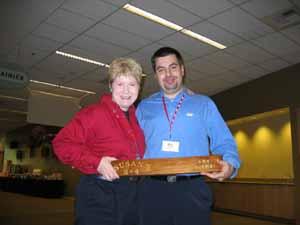
The most important, most valuable, and most worth-while part of SMB Nation was not in presentations but in the people I got to meet. If you think downloading the presentations or listening to voice recordings of the SMB Nation will get you “the jest†then you are really missing out. With the exception of one very personal presentation (mentioned below) you learn the most by talking to your colleagues, understanding what drives them, hearing their successes and failures, getting their take on what is really important. Before we are the CEO, CTO, Chief Consultant, MBA or CPA we are all people. Understanding that gives you a much better perspective and ability to be successful beyond only your profession.
To sum it up: You need to attend the SMB Nation 2006. It really is that damn good. My biggest disappointment was that I did not bother to attend before.
Robbie & Susanne: How to market more effectively to small business
Again, I’m an ASP/ISV and for my money the presentation by Robbie Upcroft and subsequent conversations with Susanne Dansey were absolutely the most valuable to my business.
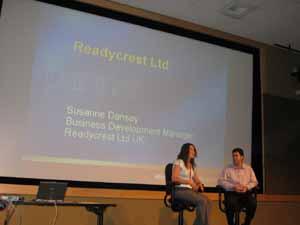
Robbie Upcroft is the UK Small Business Marketing Manager and he started the presentation by making it obvious that he is not in IT by pointing out that he is the least technical person at the conference. This is important because it is a dimension of feedback – you want to learn what people that you sell to (or try to sell to) are really thinking about your service or product. Robbie proceeded to share the customers objectives, which were: acquiring new customers, minimizing turnover, marketing their business… and not “building servers.†He reinforced this message several times and even gave away a koala toy to the person that recognized that it was not about “sbs†but the actual benefits clients can realize by having a server. As a matter of fact, one of the key notes I took back was “talk about business, not IT.â€
One of the prevalent questions was “So what?†in response to brands and features. Interesting that a Microsoft employee would say that, usually it is all about the brand. Robbie’s presentation was all about reinforcing the concept of value to the customer. The server is simply a means to an end – in productivity, security, functionality: “Your customers are not thinking about IT – they are thinking about cash flow.â€
The spotlight then shifted on a Microsoft partner in UK that drew business by organizing local events with their partners and promoted SBS. Susanne Dansey of ReadyCrest Ltd joined Robbie on stage and talked about how her company goes to market with SBS. Their business is all about SBS and they bring current and potential clients in for a seminar where they talk about SBS and present topics with their local partners (if this does not make sense scroll down to Anne Stanton’s presentation). Susanne runs a family business and is “in it for the long run†which is message everyone should strive to give their customers. Perhaps customers do not care or understand the server or IT, but they understand the need for that piece of their business to be supported. One of the key messages here was to “help clients move through stages, help build the business clients!†– this is what made me think of my own business. Would I rather deal with a family business or an ad-hoc commissioned sales person?
Robbie continued to discuss how you set customer expectations with real world examples. The message was that cost is inconsequential; you want the customer to sell to themselves by identifying what they need for their business. To borrow from another presentation by Lori Stutsman’s presentation: do not sell past the close. You do not want to flood your potential clients with the features because they just want to know how this will help them reach their business goals, not all the “cool†things it can do. Case and point: Robbie argued to drop the 2003 from “Small Business Server 2003†because to the business owner the number 2003 makes it seem like an outdated technology.
This was the best session of the conference because it gave me a 10,000 foot view of what my partners are facing and what my business needs to provide for them.
Dean & Harry: How to make more money – A talk about good business ideas
The presentation by Dean Calvert and Harry Brelsford, at least in my eyes, would have been the most valuable had it occurred three years ago when I faced the problems they talked about. I am sure we all bang our head against the wall when things go wrong; I unfortunately work in a data center so my head was bouncing against the solid steel rack frame. Dean’s presentation (and the lady Harry brought on stage) was a very deep personal share on how you build your business, how you define your success. I honestly cannot do it justice because it took me good 24 hours before I could even walk up to Dean and thank him for what he shared with all of us.
Dean’s suggestion was to operate the business targeted to serving your client base. The way to accomplish this is to know why you are in business and to set tangible goals with a realistic time-frame. Dean talking about how you should define your successes and what you want your business to look like when it is completed. With the exception of few of my friends that have taken VC funds to start their business, most people start as a one man band in which they are the business. Dean suggested that you must have an exist strategy, that is, how can you separate yourself from your business and allow it to continue without you being the main product. This hit very close to home for me because I built my business around me.
One of the priceless suggestions was to focus on monitoring the work you don’t want to do and specifically focus on the quality assurance of that work. You cannot stand and micro-manage your staff, but you need to know that the principles and priorities you set out for your business are being executed by your employees. You cannot just throw away a part of your responsibility and assume your employees (sales, office managers) are going to put in the same 16 hours a day you are.
One of the points mentioned frequently by the foreign bunch was E-Myth Revisited.
Dean suggested an exercise to help you determine if you own a business or a job. The “2 week†test assumes that you can leave your business for two weeks and see what you end up with. Think about that for a second: What would be left of your business if you left for two weeks? Do you like what you see? If not, take a look at the review of Anne Stanton below.
Anne Stanton: Creating successful affiliation partnerships in the world of small business
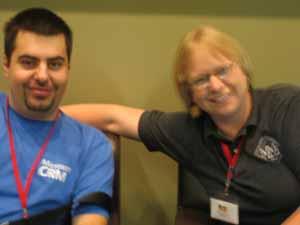
Anne Stanton, or rather, the world-famous Anne Stanton held the near-to-last presentation of the conference and it was definitely the best way to actually close out four days of meetings and presentations. Anne talked about the partnerships in the world of small business which is something that we all strive to do with our SBS user groups.
This presentation was the best because Anne presented most of it in the Q&A fashion and allowed the audience to share their successes and points of view. Sometimes these things tend to turn bloody, but Anne has something about her that only brings out the best in people. The actual presentation part talked about actually running a consulting business. How do you manage projects? How do you manage contractors? How can you work with people that are 12 hours ahead of you? How do you handle commissions, referrals, professional networking, clients, etc.
The part that most of you “small†folks will find interesting is the concept of a parallel incorporated entity. Essentially, join together with your partners for a purpose of presenting a more complete solution to your partner. Anne polled the audience on how many did not run their own wires. Then she followed up by asking the same people if they had a great relationship with the guy/gal that does wiring. Nearly every hand remained up, and I’m sure those that went down did so only to write down their need to partner up with someone that can help them.
Something I personally learned was how the consultants set commissions. At least 10% of the income goes out for advertising to gain additional business. If someone brings you business that you did not have to advertise for, you give them 10% commission. If you are being subcontracted, you should expect at least 10% commission. I understand this varies from business to business and we’ve always given a much higher commission than that, but the one thing I picked up is that you always need to provide an incentive.
Anne also covered the aspect of project management. Your contractors do not care about you (or your business, your clients) as you do: they do not put the TLC into it. You must be responsible for managing the project, the expectations, the delivery. Anne actually used the example of having her first SBS server setup by Wayne Small and what a positive experience that was. She continued to talk about the value of networking with the people in different time zones: Hey, if there is a problem at 3AM for me there is someone in a different time zone just getting back from their lunch that might be able to help me.
If you run a SBS user group or if you’re in the role that requires you to motivate cooperation with different teams in your business, you need to print this on the back of your business card, put it in the meta keywords of your web site, or engrave it any way you wish:
Anne Stanton: “You would be surprised how much business you can do with your competitors.â€
Eric Ligman: What should have been the keynote
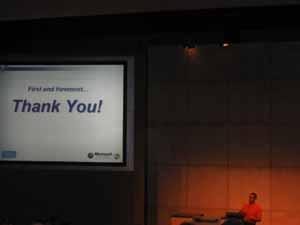
Eric Ligman, in my opinion, should have been the one delivering the SMB Nation keynote. No insult to Steven Gugenheimer, I loved the keynote, but if there was anybody at this conference that deserved more than 30 minutes it was Eric…. And he delivered more than an hours worth of content in the 30 minutes he was given.
Eric started the discussion by noting that there will be more people on foot in your region helping folks that are not yet at the Certified level. The small business community managers will be on foot doing what Eric has been doing in the virtual communities and many of the SBS user groups.
Of particular entertainment was the discussion on how to work with Microsoft. I am paraphrasing this: “There is only one right answer. If you call Microsoft and get the answer you don’t like, please don’t keep on calling back until you find the new guy that gives you the wrong answer you do like. If you ever talk to a person at Microsoft ask them to email you the location of where you can verify their claim in writing. If they say they heard, felt or thought kindly remind them that you didn’t call to hear what they heard, felt or thought – you called for an answer.†Smack.
Eric also announced the Microsoft Partner Resource Desk at (800-426-9400, x81797) which will be there to serve the small business partner community and provide an inbound partner-facing call center. If you’ve ever done business with Microsoft you know how much digging is required to get anything accomplished – well, now there is a call center to help you with it. How this was less important than the keynote “/smallbusiness†efforts I will never understand.
Amy, Kevin & Matt: Managed Services, Service Contracts, Sucessful SMB business
This actually came from three different sessions and covers content delivered by Matt Makowicz, Amy Luby and Kevin Royalty. I’m grouping them together because I honestly believe that anybody should be willing to pay at least a $1,000 to hear these three talk for 3-4 hours.

First and foremost, Kevin Royalty of Solution Net Inc. sat in the chair during the “Growing your SMB Business†and basically went through his business point by point, reading what seemed to be pages of how he runs his SMB business. I have enormous amount of respect for people that can convey their message without PowerPoint. To be quite honest, I took 3 pages of notes on what this gentleman had to say and I believe one of the future SBS group meetings will be dedicated solely to dissecting the information he delivered.
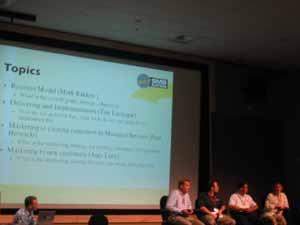
Amy Luby was on the panel of solution providers that deliver managed services. I’ve had a lot of respect for Amy prior to this presentation because I’ve seen her share her business process and how she leverages the SST roadshows for her business. Everyone can learn from Amy and her contribution to the discussion was, at least in my opinion, best practices with managed services. For example, does the fact that you manage services remotely diminish your rapport with your customer? How do you keep that relationship close without being on-site every time there is a problem? Amy is not hard to find and I hope she is given more time next year.
Matt Makowicz from the Endeavor Technologies talked about the recurring revenue and how he will never go to billing people on hourly basis again. He presented not only his business model but also how his customers see the world of billable hours. If Matt had a plan for a 7 DC / 2000+ server management contract I would have run up to the stage with my credit card much like people did for Robin Robbins. What was so impressive?
Matt shared 7 steps to the service contract sale:
1. Establish credibility (testimonials, referrals)
2. Establish a general problem (why am I here?)
3. Establish a specific problem (bad backup)
4. Offer a solution
5. Compare price (to do-it-yourself IT staff salary)
6. Give a reason (they will eventually need you, but what do you have to offer today to get them signed up)
7. Ask for the order
I find #6 particularly interesting because that is the key part of selling the model. According to Matt, every day that goes by reduces the number of reasons they have to hire you. Matt positions this approach as a solution, not the fix: “Make the problem go away vs. This never would have happened in the first placeâ€
Matt also spoke about handling complaints and actually helping grow the customers business. With hourly biling (or blocks of time) you collect the money up front – so in the customers eyes, what is your motivation to exceed their expectations if you’ve already gotten paid? What is your sense of urgency? More importantly, they know that every minute they talk to you is on the clock so how great of a rapport are you establishing?
Service contracts on the other hand provide a proactive approach to managing your clients business. Matt shared that he approaches the business owners when they set their budgets. “Clients hate bills, clients hate surprises†– by being present when they set their budget you can make them aware of what they will be required to pay at which point (your AV license expires in July, make sure you put that in your budget).
It is not all about the business..
It is about people, about real life concerns. Jeff Midleton presented a very motivational and uplifting speech about the Katrina catastrophy and it was extremely refreshing to see someone take up a goliath effort instead of just passing the collection dish. Don’t get me wrong, I think we’re some of the most generous and selfless people when something tragic happens, but I love to see when people like Jeff decide to do more than just “donate†to a fund. His point was that the only way for New Orleans to recover is to bring the small business back and have people give money to the small business.
Jeff discussed his initiative to organize a small business helpdesk where a small business owner can walk up with his computer, hard drive and say “My business is in this box, it won’t bootâ€. Jeff has received support from Microsoft and Lewis Lin (not just with hosting of the project and software donations) but also with offer to help pay for some T&E stipend consultants will need if they are willing to go to the affected areas and help get small business back on their fee. If you have any way you can help this effort please contact Jeff at www.sbsmigration.com and see what you can do. Jeff was very clear that he has no intention of “replacing†something that already exists or bypassing Red Cross or FEMA – he wants to help the small business in the area where Red Cross and FEMA have no experience.

SMB Nation was not all serious or business – we had a lot of fun. My engine was running low and I finally crashed on Saturday night after weeks of sleepless geeking. To the right is the only picture I can legally share with you. There is very little I can share about the partying efforts.. C:


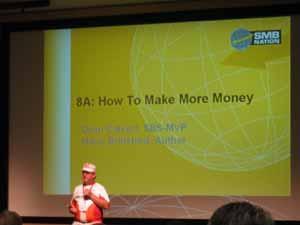

 For the less coherent, more grammatically correct realtime insight, follow me on Twitter at
For the less coherent, more grammatically correct realtime insight, follow me on Twitter at
6 Responses to SMB Nation 2005: My take